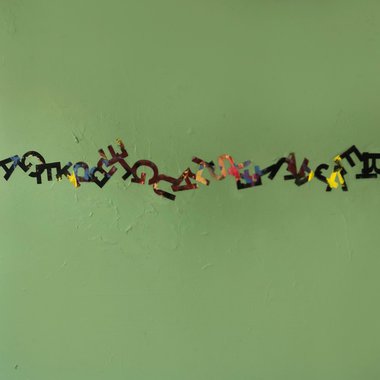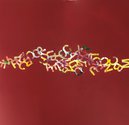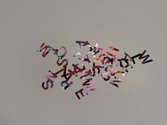John Hurrell – 6 July, 2021
In his artist statement Riley speaks of our current social climate as an age of unpredictability, where the world seems chaotic, and he is making anxious images that reflect that disorder. He sees them as a sort of shield that protects the individual against the daily pressures of multiple uncertainties. The jumbled texts are to him a wall of defense, a way of psychologically adjusting to the catastrophic shambles our planet and humanity finds itself in, and a way of (temporarily?) rejecting traditional painting practices.
Six paintings adorn the sitting room of Antoinette Godkin’s apartment: textured monochromes that are interrupted by horizontal lines of tumbling (sometimes overlapping) block letters that are rarely upright; usually sideways, inverted, or on their backs.
Here older, earlier impastoed paintings made by Bill Riley (of landscapes, portraits, ‘conceptual’ climate protest and other genres, each with its own set of conventions and codes) have been painted over so that traces of turbulently mixed colours are visible peeking through the lines of the sans serif letter shapes. The letters are in random order; they don’t make up recognisable words—yet the colourful strings of assorted graphemes are enigmatic and visually elegant.
In his artist statement Riley speaks of our current social climate as an age of unpredictability, where the world seems chaotic, and he is making anxious images that reflect that disorder. He sees them as a sort of shield that protects the individual against the daily pressures of multiple uncertainties. The jumbled texts are to him a wall of defense—a calculated gesture of acknowledged confusion—a way of psychologically adjusting to the catastrophic shambles our planet and humanity finds itself in, and a way of (temporarily?) rejecting traditional painting practices.
Personally, being an optimist, this writer sees no reason for despair. I’m a great believer in the maxim that the past explains the present, and that the present can be rationally made sense of, even the chaotic present which—for sure—is particularly fractious in current times. These paintings can be interpreted in many ways.
Focussing on this exhibition and its particular qualities: when a visitor mentally encounters these works their first approach is likely to be that of engaging with a puzzle: can the letters be straightened up and sorted into words which can then be placed in a sequence that generates meaning? Or are the letters instead drawn out of a hat or are they anagrams of words (like say, colour names) or short phrases that might reference historical change or types of modern crisis?
They seem aleatoric, but the vowel / consonant ratio also suggests a hidden underpinning structure. If picked by chance, maybe some parts of the letter sequences might lead to free association and new unpredictable thoughts that Riley would find enjoyable or of interest. In other words, they would move away from defence towards offence—a moving out towards new conceptual territory where language can be reorganised (like a cast net) to pull in zones of thought unforeseen.
That the letters are in a horizontal row is interesting; like ciphers impaled on a stretched wire, or letters caught in a twisting torque about to be released, each capable of fluttering in a whir independent of its companions—unlike say airport arrival signs—moving at different speeds. Perhaps if we watch closely (maybe in a hallucinatory state brought on by exhaustion) new texts will appear that have coherence and wisdom. A little positivity.
John Hurrell






 Advertising in this column
Advertising in this column Two Rooms presents a program of residencies and projects
Two Rooms presents a program of residencies and projects



This Discussion has 0 comments.
Comment
Participate
Register to Participate.
Sign in
Sign in to an existing account.